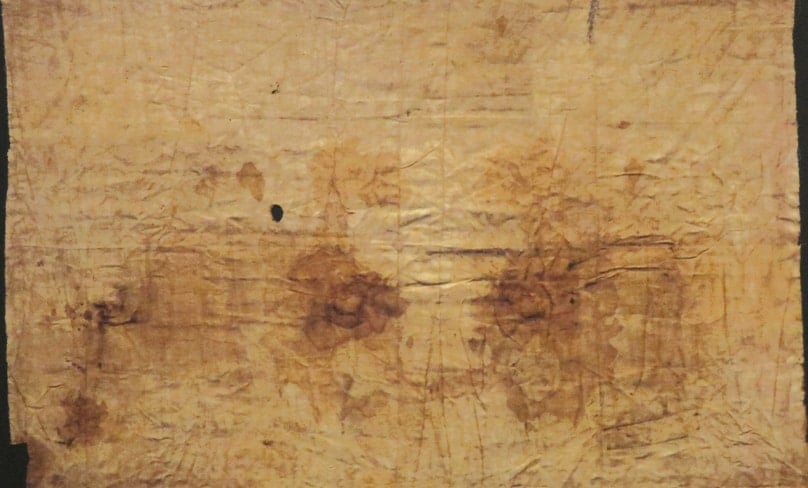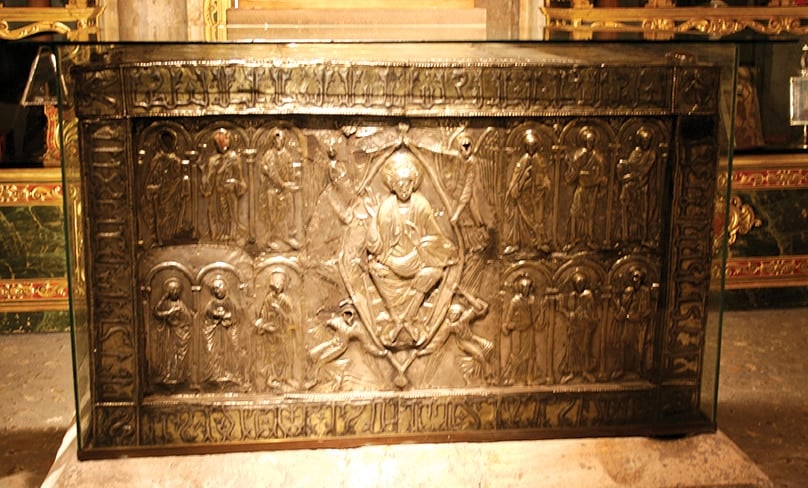
Dear Father, I understand it is claimed that the cloth which was wrapped around Jesus’ head after he died is now in the cathedral of Oviedo in Spain. Is there any evidence for this?
There is substantial evidence that the so-called Sudarium, literally sweat cloth or face cloth, in Oviedo is the one that was wrapped around Jesus’ head when he died.
St John records how on Easter Sunday morning when St Peter entered the tomb he saw “the linen cloths lying, and the napkin, which had been on his head, not lying with the linen cloths but rolled up in a place by itself” (Jn 20:6-7).
That napkin would be the Sudarium now in Oviedo. The history of the cloth is well documented, especially by the twelfth-century bishop of Oviedo, Pelayo. According to this history, the Sudarium was in Palestine until shortly before the year 614, when Chosroes II, king of Persia, attacked and conquered Jerusalem.
It was taken in a chest with other relics first to Alexandria, Egypt, by the presbyter Philip, and then across the north of Africa to Spain, where it was given to Leandro, bishop of Seville.
“The Sudarium is a piece of cloth measuring 84 by 53 centimetres. It has no image but only numerous stains made by blood and other substances.”
When St Isidore became bishop of Seville he entrusted the chest with the relics to St Ildefonso, who had been appointed bishop of Toledo. The chest stayed in Toledo until the year 718, when it was taken further north to avoid capture by the Moors, who were advancing through the Iberian peninsula.
It was first kept in a cave, now called Monsacro, near Oviedo and then taken to a special chapel in the cathedral of Oviedo. There it was opened on 14 March 1075 in the presence of King Alfonso VI. A list was made of all the relics, including the Sudarium, and the chest was covered with silver plating with an inscription inviting Christians to venerate the relics. It has remained there ever since.
The Sudarium is a piece of cloth measuring 84 by 53 centimetres. It has no image but only numerous stains made by blood and other substances.
The reason for the Sudarium is that Jewish tradition demanded that if the face of a dead person was in any way disfigured, as was that of Jesus, it should be covered with a cloth so as not to be seen. Recent tests carried out on the cloth by scientists from the Spanish Centre for Sindonology have yielded some remarkable results.

First, it is evident that the man whose face was covered by the cloth died in an upright position, consistent with crucifixion.
The stains consist of one part blood and six parts oedema fluid, which collects in the lungs when a crucified person dies of asphyxiation. If the body suffers jolting movements, the fluid can come out through the nostrils. The oedema stains near the nose are superimposed on each other, in such a way that the earlier stains had already dried when the later ones were formed. The marks of the fingers that held the cloth to the nose are visible.
The cloth was most likely placed on the head when the body was still on the cross. The second stains were made about an hour later, when the body was taken down from the cross and laid on the ground.
The third stains came some forty-five minutes after this, when the body was lifted from the ground and taken for burial. The Sudarium was most likely removed before the person was buried, explaining why it was found wrapped up by itself. In addition to the main stains there are smaller bloodstains all over the head made by small sharp objects, like thorns.
“There are remarkable similarities between the Sudarium and the Shroud of Turin.”
There is pollen on the cloth, as found in Oviedo, Toledo, North Africa and Jerusalem, confirming the route taken by the cloth. And there are residues most probably of myrrh and aloes, as described in the Gospel (cf. Jn 19:39-40). The person covered by the cloth had typically Jewish features, including a prominent nose and pronounced cheekbones.
Remarkable similarities
There are remarkable similarities between the Sudarium and the Shroud of Turin. The nose is exactly the same length, about eight centimetres. The blood type is the same, the rare AB type. If the face on the Shroud of Turin is placed over the stains on the Sudarium, there is an exact correspondence of the stains with the beard on the face.
Likewise, the thorn stains on the nape of the neck coincide perfectly with those on the Shroud. In fact, there are a total of seventy points of coincidence with the stains on the front of the Shroud and fifty on the back.
The conclusion is that the Sudarium of Oviedo covered the same face as the Shroud of Turin, most likely that of Jesus of Nazareth. The very fact that the cloth was kept at all and was so well documented points to its authenticity, since in itself it has no artistic or monetary value.
Related Articles
